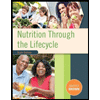Sarah is a 20-year-old female who is a student athlete. She is 5’ 3” tall and weighs 112 pounds. She participates in varsity swimming, practicing two hours a day, six days a week. Her main source of nutrition is the dining hall of the college, but she occasionally snacks on reduced-fat cookies while studying. Sarah states that she rarely eats breakfast, except on days of competition, but does eat lunch and dinner every day with her friends. These meals usually consist of cereal, a salad, or a sandwich. Because Sarah started swimming this semester, she reports having lost about 15 pounds over the past 3 months. She would like to resume her earlier weight but is concerned about the risks of eating foods high in fat. What may have contributed to Sarah’s loss of weight? Some of the factors that may have contributed to Sarah’s loss of weight include inadequate nutritional intake for the amount of activity. Some of the factors that may have contributed to Sarah’s loss of weight include skipping breakfast and inadequate nutritional intake for the amount of activity. The main factor that may have contributed to Sarah’s loss of weight is the fact that she plays too many sports. Recommended that she sticks to only one. Sara's weight is normal. she does not have a weight loss problem.
Sarah is a 20-year-old female who is a student athlete. She is 5’ 3” tall and weighs 112 pounds. She participates in varsity swimming, practicing two hours a day, six days a week. Her main source of nutrition is the dining hall of the college, but she occasionally snacks on reduced-fat cookies while studying. Sarah states that she rarely eats breakfast, except on days of competition, but does eat lunch and dinner every day with her friends. These meals usually consist of cereal, a salad, or a sandwich. Because Sarah started swimming this semester, she reports having lost about 15 pounds over the past 3 months. She would like to resume her earlier weight but is concerned about the risks of eating foods high in fat.
What may have contributed to Sarah’s loss of weight?
- Some of the factors that may have contributed to Sarah’s loss of weight include inadequate nutritional intake for the amount of activity.
- Some of the factors that may have contributed to Sarah’s loss of weight include skipping breakfast and inadequate nutritional intake for the amount of activity.
- The main factor that may have contributed to Sarah’s loss of weight is the fact that she plays too many sports. Recommended that she sticks to only one.
- Sara's weight is normal. she does not have a weight loss problem.
QUESTION 2
- What dietary strategies might help Sarah regain the weight lost?
- Select one or more answers
- Energy in should exceed energy out by at least 500 kcalories/day. Increase your food intake enough to store more energy than you spend in exercise. Exercise and eat to build muscles.
- Expect weight gain to take time (1 pound per month would be reasonable).
- Eat snacks between meals and drink plenty of juice and milk.
- Emphasize energy-dense foods.
- Eat large portions of foods and expect to feel to be hungry.
- Eat at least three meals per day.
QUESTION 3
Select one or more answers
- What are the risks of continued weight loss?
- Female athletes are vulnerable to extreme weight loss and eating disorders. If weight loss goes too far, athletes can “lose so much lean tissue that basal
metabolic rate slows. - Starvation brings other physical consequences as well: loss of brain tissue, impaired immune response, anemia, and a loss of digestive function that worsens malnutrition
- The person may suffer from diarrhea, further worsening malnutrition.
- Additionally, the heart pumps inefficiently and irregularly, the heart muscle becomes weak and thin, the heart chambers diminish in size, and the blood pressure falls.
QUESTION 4
- Sarah is a 20-year-old, 5’ 3” tall and weighs 112 pounds
Select one answer.
- What is her BMI?
- 8 and considered underweight
- 8 and considered within normal weight category
- 8 and considered overweight for an athlete
- 8 and considered underweight for an athlete
QUESTION 5
- Sarah is a 20-year-old female who is a student athlete. She is 5’ 3” tall and weighs 112 pounds. She participates in varsity swimming, practicing two hours a day, six days a week. Her main source of nutrition is the dining hall of the college, but she occasionally snacks on reduced-fat cookies while studying. Sarah states that she rarely eats breakfast, except on days of competition, but does eat lunch and dinner every day with her friends. These meals usually consist of cereal, a salad, or a sandwich. Because Sarah started swimming this semester, she reports having lost about 15 pounds over the past 3 months. She would like to resume her earlier weight but is concerned about the risks of eating foods high in fat.
- How could you respond to her concern about eating foods high in fat?
Select one answer
- She should be told that some fat is necessary in her diet and many fats are heart healthy.
- It is important that she include at least the equivalent of a teaspoon of fat (unsaturated oils, nuts, and peanut butter are recommended) in every meal to supply her essential fatty acids and fat-soluble vitamins.
- None of the above
- All of the above
Fat is needed to produce the natural oils in the skin, add gloss to hair, insulate the body from extreme temperatures, and cushion the organs from damage. Fat provides energy for the working muscles.
True
False
Trending now
This is a popular solution!
Step by step
Solved in 2 steps

- What dietary strategies might help Sarah regain the weight lost?








